International Business Finance: Project Financial Viability Analysis
VerifiedAdded on 2021/04/21
|11
|2234
|95
Report
AI Summary
This report provides a detailed financial analysis of a new project to be conducted in Brazil by a US company, focusing on its financial viability and performance. The analysis includes calculating free cash flow, evaluating hedging strategies for currency risk, and assessing the implications of using debt from both Brazilian and US sources. The report also examines the factors driving differences between financial options and the potential impact of a financial crisis on the project. The findings suggest that hedging currency risk and utilizing debt from the Brazilian subsidiary, rather than the US parent company, are the most financially sound strategies. The report concludes with a recommendation to proceed with the project under specific conditions and emphasizes the importance of currency risk management to maximize returns on investment. The analysis uses NPV calculations to support its recommendations.
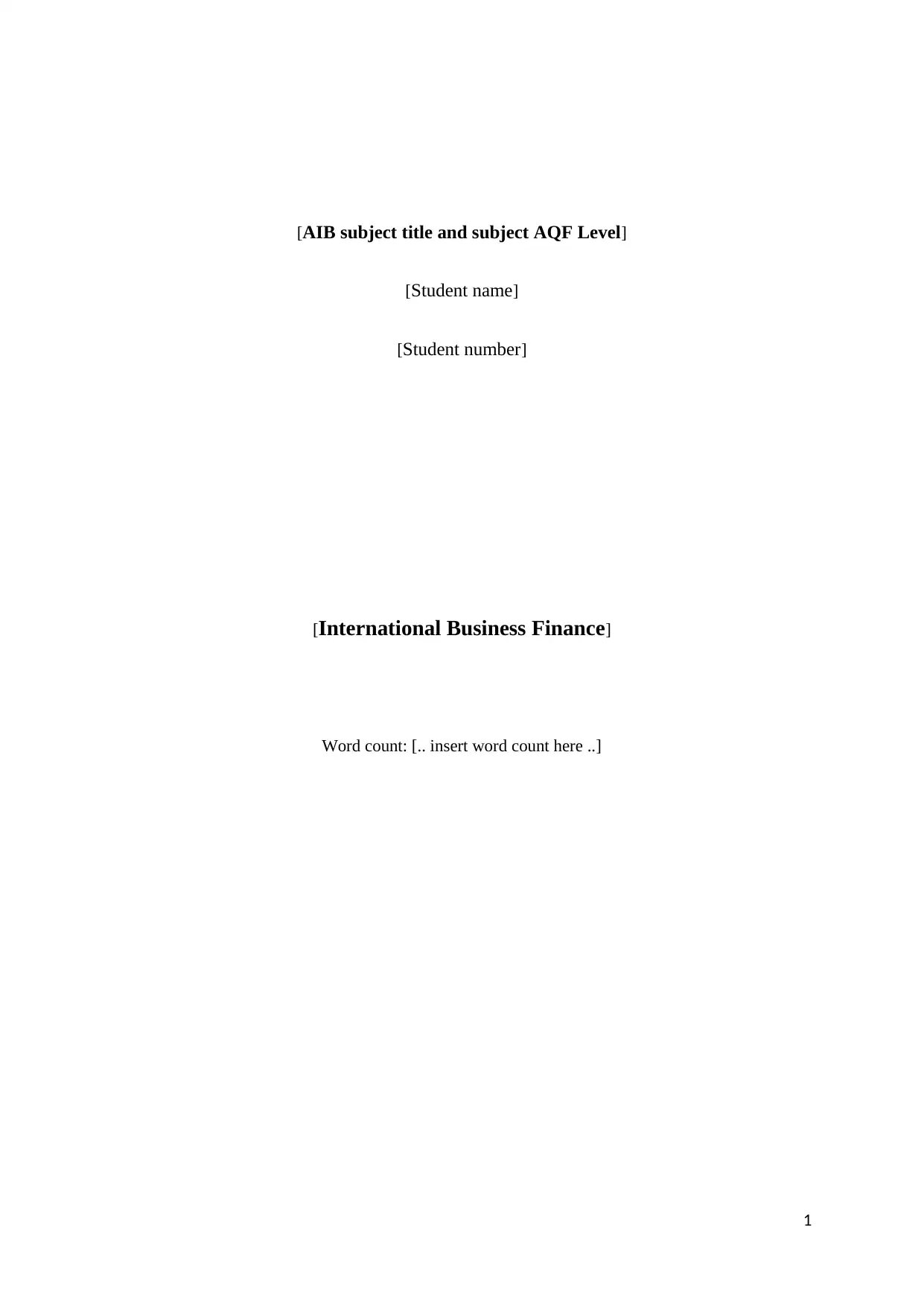
[AIB subject title and subject AQF Level]
[Student name]
[Student number]
[International Business Finance]
Word count: [.. insert word count here ..]
1
[Student name]
[Student number]
[International Business Finance]
Word count: [.. insert word count here ..]
1
Secure Best Marks with AI Grader
Need help grading? Try our AI Grader for instant feedback on your assignments.
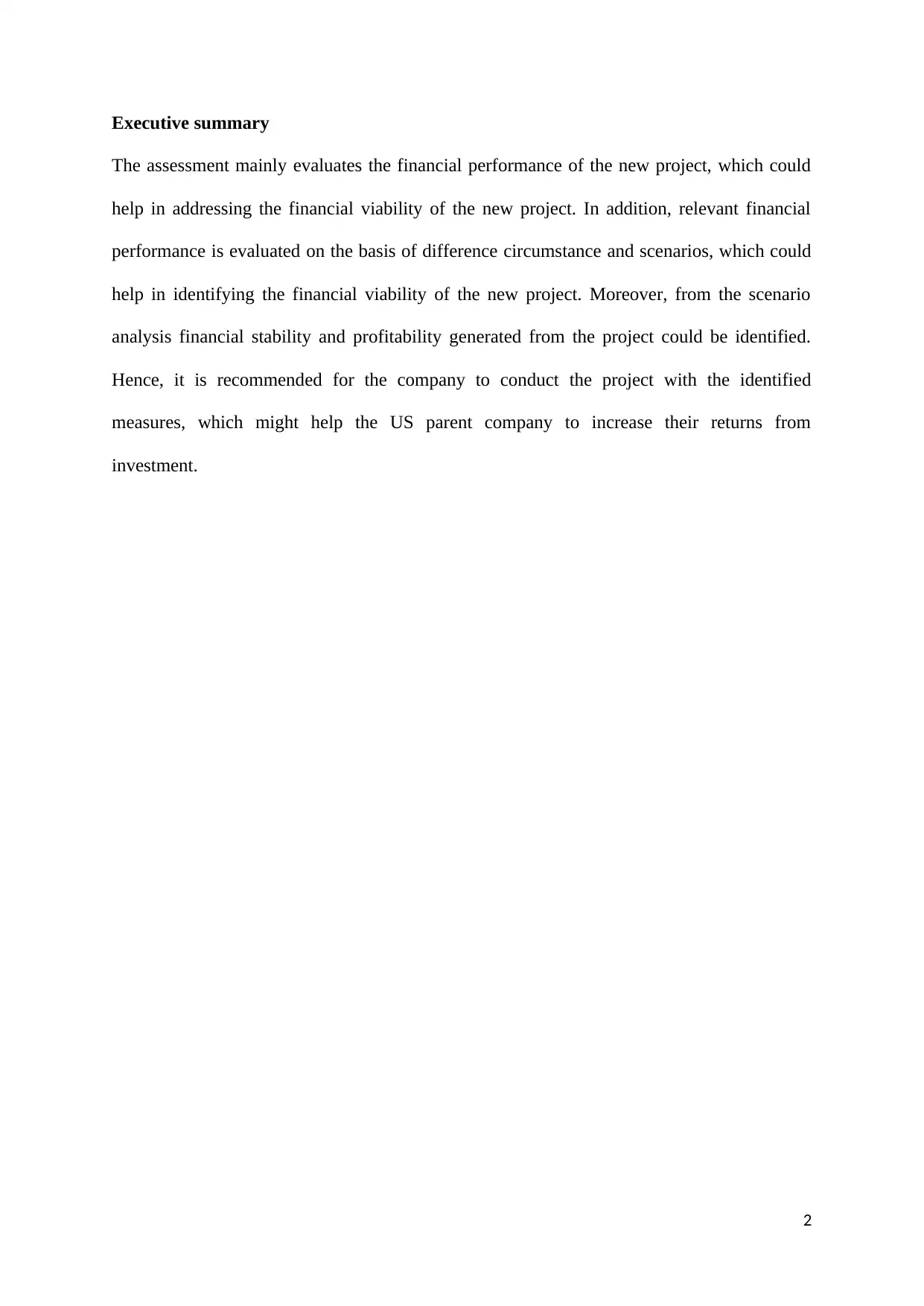
Executive summary
The assessment mainly evaluates the financial performance of the new project, which could
help in addressing the financial viability of the new project. In addition, relevant financial
performance is evaluated on the basis of difference circumstance and scenarios, which could
help in identifying the financial viability of the new project. Moreover, from the scenario
analysis financial stability and profitability generated from the project could be identified.
Hence, it is recommended for the company to conduct the project with the identified
measures, which might help the US parent company to increase their returns from
investment.
2
The assessment mainly evaluates the financial performance of the new project, which could
help in addressing the financial viability of the new project. In addition, relevant financial
performance is evaluated on the basis of difference circumstance and scenarios, which could
help in identifying the financial viability of the new project. Moreover, from the scenario
analysis financial stability and profitability generated from the project could be identified.
Hence, it is recommended for the company to conduct the project with the identified
measures, which might help the US parent company to increase their returns from
investment.
2
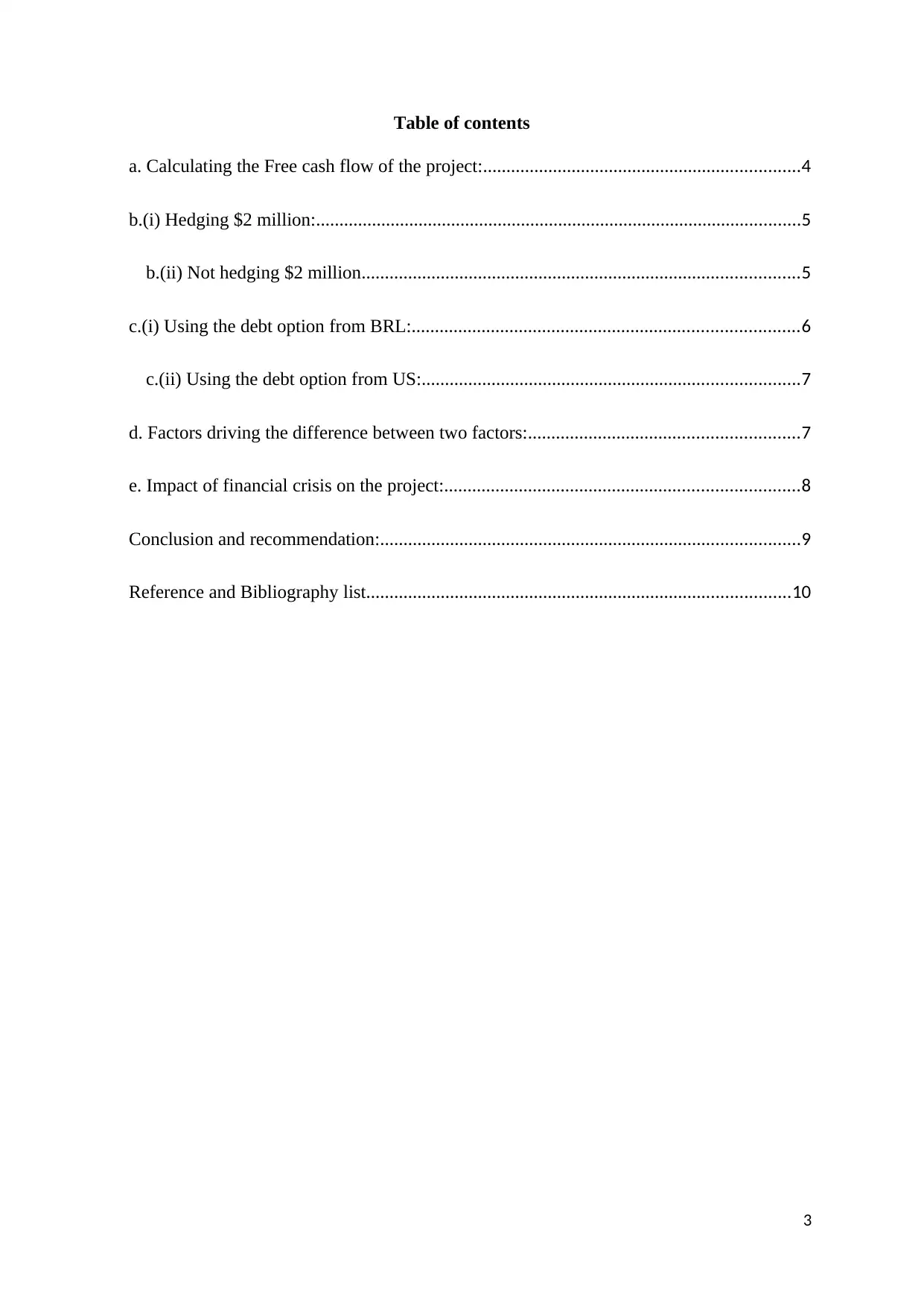
Table of contents
a. Calculating the Free cash flow of the project:....................................................................4
b.(i) Hedging $2 million:........................................................................................................5
b.(ii) Not hedging $2 million..............................................................................................5
c.(i) Using the debt option from BRL:...................................................................................6
c.(ii) Using the debt option from US:.................................................................................7
d. Factors driving the difference between two factors:..........................................................7
e. Impact of financial crisis on the project:............................................................................8
Conclusion and recommendation:..........................................................................................9
Reference and Bibliography list...........................................................................................10
3
a. Calculating the Free cash flow of the project:....................................................................4
b.(i) Hedging $2 million:........................................................................................................5
b.(ii) Not hedging $2 million..............................................................................................5
c.(i) Using the debt option from BRL:...................................................................................6
c.(ii) Using the debt option from US:.................................................................................7
d. Factors driving the difference between two factors:..........................................................7
e. Impact of financial crisis on the project:............................................................................8
Conclusion and recommendation:..........................................................................................9
Reference and Bibliography list...........................................................................................10
3
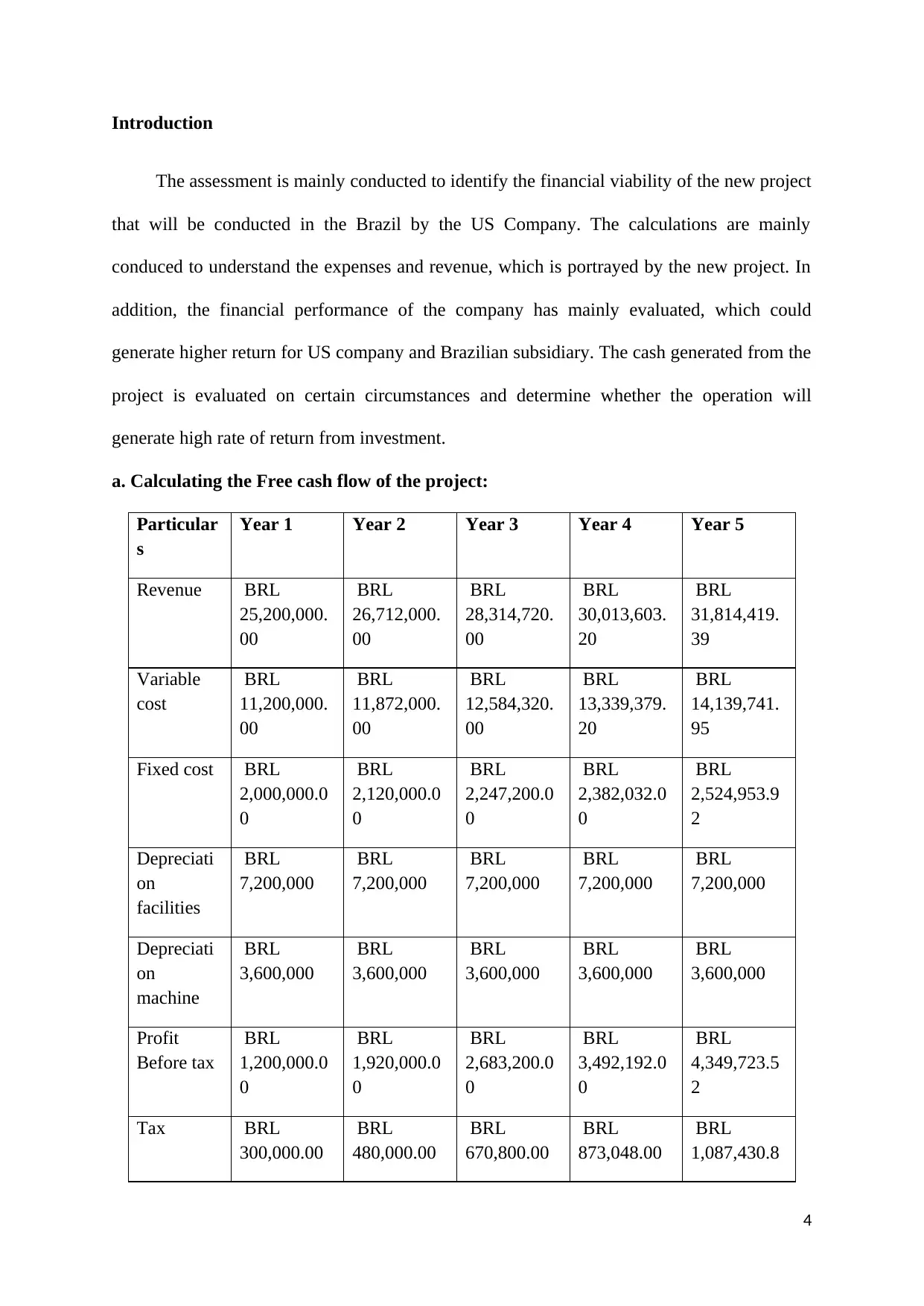
Introduction
The assessment is mainly conducted to identify the financial viability of the new project
that will be conducted in the Brazil by the US Company. The calculations are mainly
conduced to understand the expenses and revenue, which is portrayed by the new project. In
addition, the financial performance of the company has mainly evaluated, which could
generate higher return for US company and Brazilian subsidiary. The cash generated from the
project is evaluated on certain circumstances and determine whether the operation will
generate high rate of return from investment.
a. Calculating the Free cash flow of the project:
Particular
s
Year 1 Year 2 Year 3 Year 4 Year 5
Revenue BRL
25,200,000.
00
BRL
26,712,000.
00
BRL
28,314,720.
00
BRL
30,013,603.
20
BRL
31,814,419.
39
Variable
cost
BRL
11,200,000.
00
BRL
11,872,000.
00
BRL
12,584,320.
00
BRL
13,339,379.
20
BRL
14,139,741.
95
Fixed cost BRL
2,000,000.0
0
BRL
2,120,000.0
0
BRL
2,247,200.0
0
BRL
2,382,032.0
0
BRL
2,524,953.9
2
Depreciati
on
facilities
BRL
7,200,000
BRL
7,200,000
BRL
7,200,000
BRL
7,200,000
BRL
7,200,000
Depreciati
on
machine
BRL
3,600,000
BRL
3,600,000
BRL
3,600,000
BRL
3,600,000
BRL
3,600,000
Profit
Before tax
BRL
1,200,000.0
0
BRL
1,920,000.0
0
BRL
2,683,200.0
0
BRL
3,492,192.0
0
BRL
4,349,723.5
2
Tax BRL
300,000.00
BRL
480,000.00
BRL
670,800.00
BRL
873,048.00
BRL
1,087,430.8
4
The assessment is mainly conducted to identify the financial viability of the new project
that will be conducted in the Brazil by the US Company. The calculations are mainly
conduced to understand the expenses and revenue, which is portrayed by the new project. In
addition, the financial performance of the company has mainly evaluated, which could
generate higher return for US company and Brazilian subsidiary. The cash generated from the
project is evaluated on certain circumstances and determine whether the operation will
generate high rate of return from investment.
a. Calculating the Free cash flow of the project:
Particular
s
Year 1 Year 2 Year 3 Year 4 Year 5
Revenue BRL
25,200,000.
00
BRL
26,712,000.
00
BRL
28,314,720.
00
BRL
30,013,603.
20
BRL
31,814,419.
39
Variable
cost
BRL
11,200,000.
00
BRL
11,872,000.
00
BRL
12,584,320.
00
BRL
13,339,379.
20
BRL
14,139,741.
95
Fixed cost BRL
2,000,000.0
0
BRL
2,120,000.0
0
BRL
2,247,200.0
0
BRL
2,382,032.0
0
BRL
2,524,953.9
2
Depreciati
on
facilities
BRL
7,200,000
BRL
7,200,000
BRL
7,200,000
BRL
7,200,000
BRL
7,200,000
Depreciati
on
machine
BRL
3,600,000
BRL
3,600,000
BRL
3,600,000
BRL
3,600,000
BRL
3,600,000
Profit
Before tax
BRL
1,200,000.0
0
BRL
1,920,000.0
0
BRL
2,683,200.0
0
BRL
3,492,192.0
0
BRL
4,349,723.5
2
Tax BRL
300,000.00
BRL
480,000.00
BRL
670,800.00
BRL
873,048.00
BRL
1,087,430.8
4
Secure Best Marks with AI Grader
Need help grading? Try our AI Grader for instant feedback on your assignments.
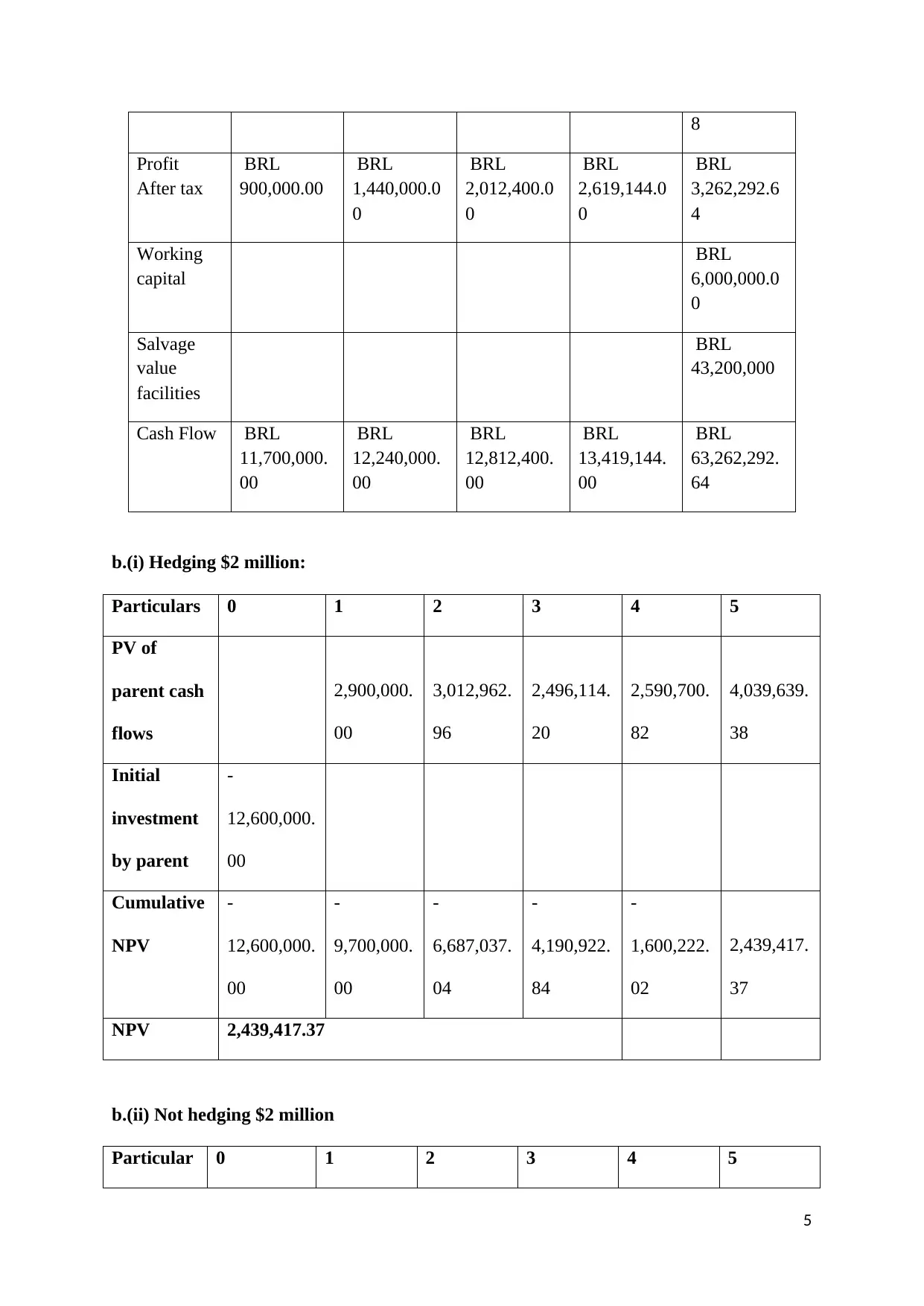
8
Profit
After tax
BRL
900,000.00
BRL
1,440,000.0
0
BRL
2,012,400.0
0
BRL
2,619,144.0
0
BRL
3,262,292.6
4
Working
capital
BRL
6,000,000.0
0
Salvage
value
facilities
BRL
43,200,000
Cash Flow BRL
11,700,000.
00
BRL
12,240,000.
00
BRL
12,812,400.
00
BRL
13,419,144.
00
BRL
63,262,292.
64
b.(i) Hedging $2 million:
Particulars 0 1 2 3 4 5
PV of
parent cash
flows
2,900,000.
00
3,012,962.
96
2,496,114.
20
2,590,700.
82
4,039,639.
38
Initial
investment
by parent
-
12,600,000.
00
Cumulative
NPV
-
12,600,000.
00
-
9,700,000.
00
-
6,687,037.
04
-
4,190,922.
84
-
1,600,222.
02
2,439,417.
37
NPV 2,439,417.37
b.(ii) Not hedging $2 million
Particular 0 1 2 3 4 5
5
Profit
After tax
BRL
900,000.00
BRL
1,440,000.0
0
BRL
2,012,400.0
0
BRL
2,619,144.0
0
BRL
3,262,292.6
4
Working
capital
BRL
6,000,000.0
0
Salvage
value
facilities
BRL
43,200,000
Cash Flow BRL
11,700,000.
00
BRL
12,240,000.
00
BRL
12,812,400.
00
BRL
13,419,144.
00
BRL
63,262,292.
64
b.(i) Hedging $2 million:
Particulars 0 1 2 3 4 5
PV of
parent cash
flows
2,900,000.
00
3,012,962.
96
2,496,114.
20
2,590,700.
82
4,039,639.
38
Initial
investment
by parent
-
12,600,000.
00
Cumulative
NPV
-
12,600,000.
00
-
9,700,000.
00
-
6,687,037.
04
-
4,190,922.
84
-
1,600,222.
02
2,439,417.
37
NPV 2,439,417.37
b.(ii) Not hedging $2 million
Particular 0 1 2 3 4 5
5
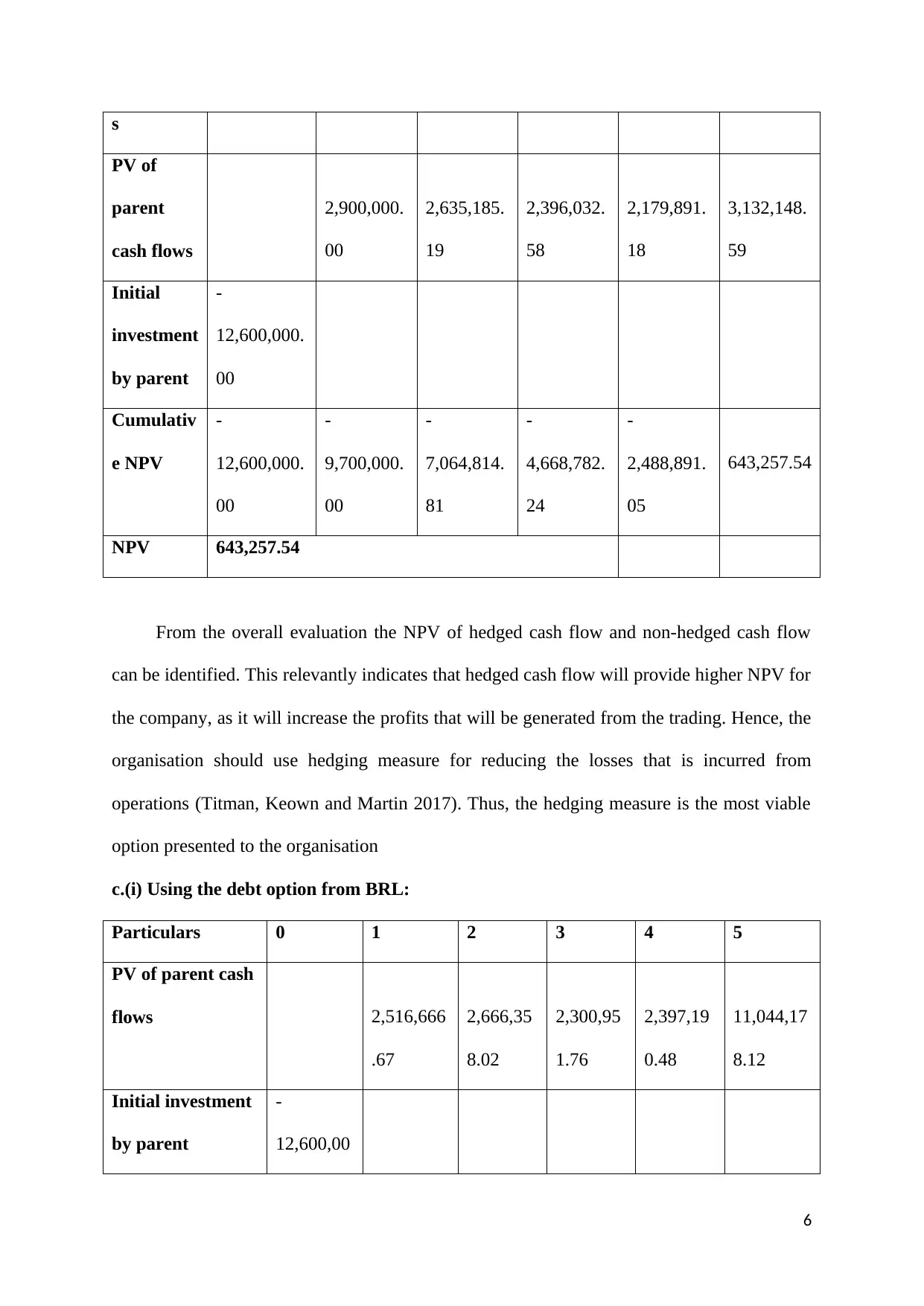
s
PV of
parent
cash flows
2,900,000.
00
2,635,185.
19
2,396,032.
58
2,179,891.
18
3,132,148.
59
Initial
investment
by parent
-
12,600,000.
00
Cumulativ
e NPV
-
12,600,000.
00
-
9,700,000.
00
-
7,064,814.
81
-
4,668,782.
24
-
2,488,891.
05
643,257.54
NPV 643,257.54
From the overall evaluation the NPV of hedged cash flow and non-hedged cash flow
can be identified. This relevantly indicates that hedged cash flow will provide higher NPV for
the company, as it will increase the profits that will be generated from the trading. Hence, the
organisation should use hedging measure for reducing the losses that is incurred from
operations (Titman, Keown and Martin 2017). Thus, the hedging measure is the most viable
option presented to the organisation
c.(i) Using the debt option from BRL:
Particulars 0 1 2 3 4 5
PV of parent cash
flows 2,516,666
.67
2,666,35
8.02
2,300,95
1.76
2,397,19
0.48
11,044,17
8.12
Initial investment
by parent
-
12,600,00
6
PV of
parent
cash flows
2,900,000.
00
2,635,185.
19
2,396,032.
58
2,179,891.
18
3,132,148.
59
Initial
investment
by parent
-
12,600,000.
00
Cumulativ
e NPV
-
12,600,000.
00
-
9,700,000.
00
-
7,064,814.
81
-
4,668,782.
24
-
2,488,891.
05
643,257.54
NPV 643,257.54
From the overall evaluation the NPV of hedged cash flow and non-hedged cash flow
can be identified. This relevantly indicates that hedged cash flow will provide higher NPV for
the company, as it will increase the profits that will be generated from the trading. Hence, the
organisation should use hedging measure for reducing the losses that is incurred from
operations (Titman, Keown and Martin 2017). Thus, the hedging measure is the most viable
option presented to the organisation
c.(i) Using the debt option from BRL:
Particulars 0 1 2 3 4 5
PV of parent cash
flows 2,516,666
.67
2,666,35
8.02
2,300,95
1.76
2,397,19
0.48
11,044,17
8.12
Initial investment
by parent
-
12,600,00
6
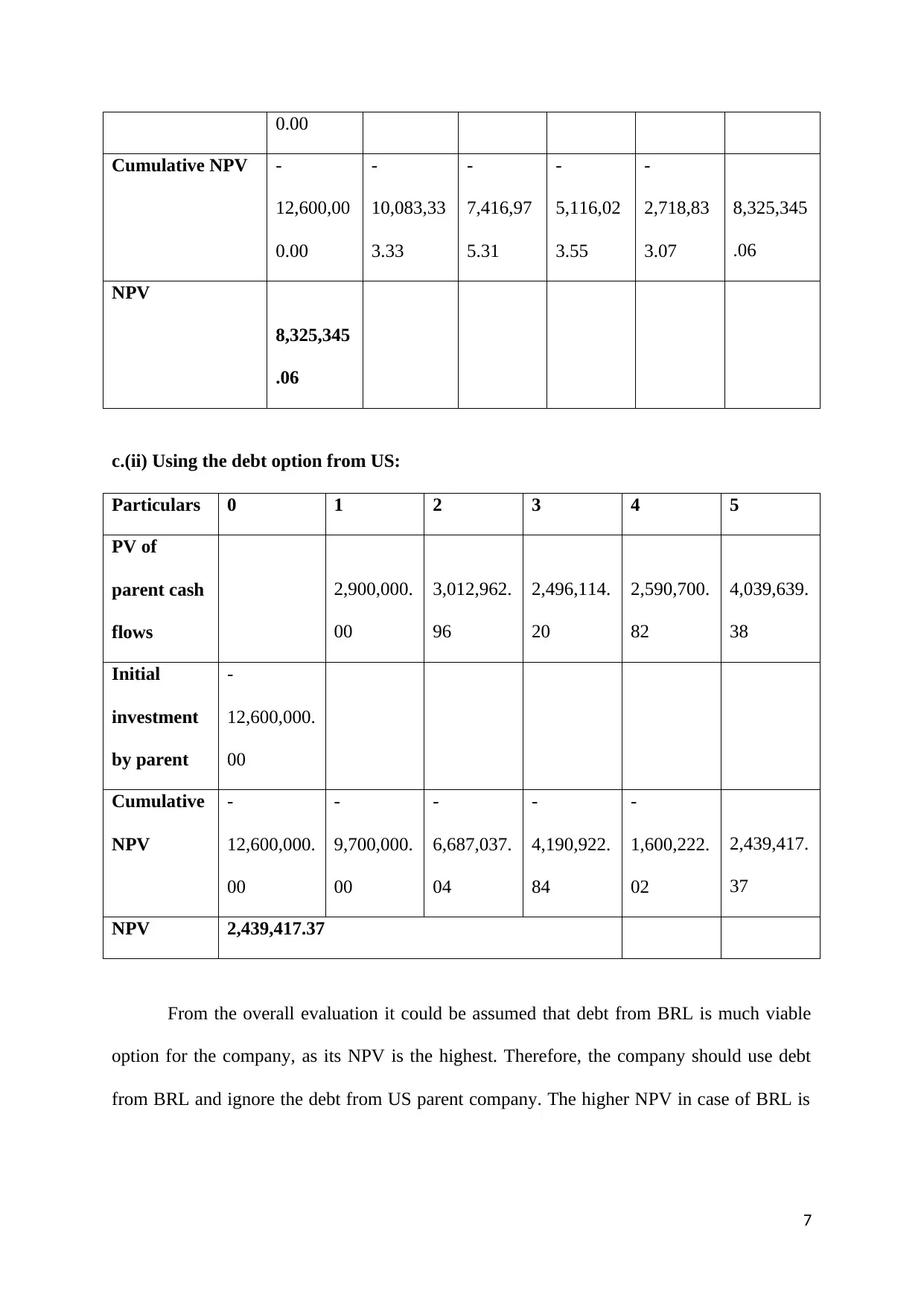
0.00
Cumulative NPV -
12,600,00
0.00
-
10,083,33
3.33
-
7,416,97
5.31
-
5,116,02
3.55
-
2,718,83
3.07
8,325,345
.06
NPV
8,325,345
.06
c.(ii) Using the debt option from US:
Particulars 0 1 2 3 4 5
PV of
parent cash
flows
2,900,000.
00
3,012,962.
96
2,496,114.
20
2,590,700.
82
4,039,639.
38
Initial
investment
by parent
-
12,600,000.
00
Cumulative
NPV
-
12,600,000.
00
-
9,700,000.
00
-
6,687,037.
04
-
4,190,922.
84
-
1,600,222.
02
2,439,417.
37
NPV 2,439,417.37
From the overall evaluation it could be assumed that debt from BRL is much viable
option for the company, as its NPV is the highest. Therefore, the company should use debt
from BRL and ignore the debt from US parent company. The higher NPV in case of BRL is
7
Cumulative NPV -
12,600,00
0.00
-
10,083,33
3.33
-
7,416,97
5.31
-
5,116,02
3.55
-
2,718,83
3.07
8,325,345
.06
NPV
8,325,345
.06
c.(ii) Using the debt option from US:
Particulars 0 1 2 3 4 5
PV of
parent cash
flows
2,900,000.
00
3,012,962.
96
2,496,114.
20
2,590,700.
82
4,039,639.
38
Initial
investment
by parent
-
12,600,000.
00
Cumulative
NPV
-
12,600,000.
00
-
9,700,000.
00
-
6,687,037.
04
-
4,190,922.
84
-
1,600,222.
02
2,439,417.
37
NPV 2,439,417.37
From the overall evaluation it could be assumed that debt from BRL is much viable
option for the company, as its NPV is the highest. Therefore, the company should use debt
from BRL and ignore the debt from US parent company. The higher NPV in case of BRL is
7
Paraphrase This Document
Need a fresh take? Get an instant paraphrase of this document with our AI Paraphraser
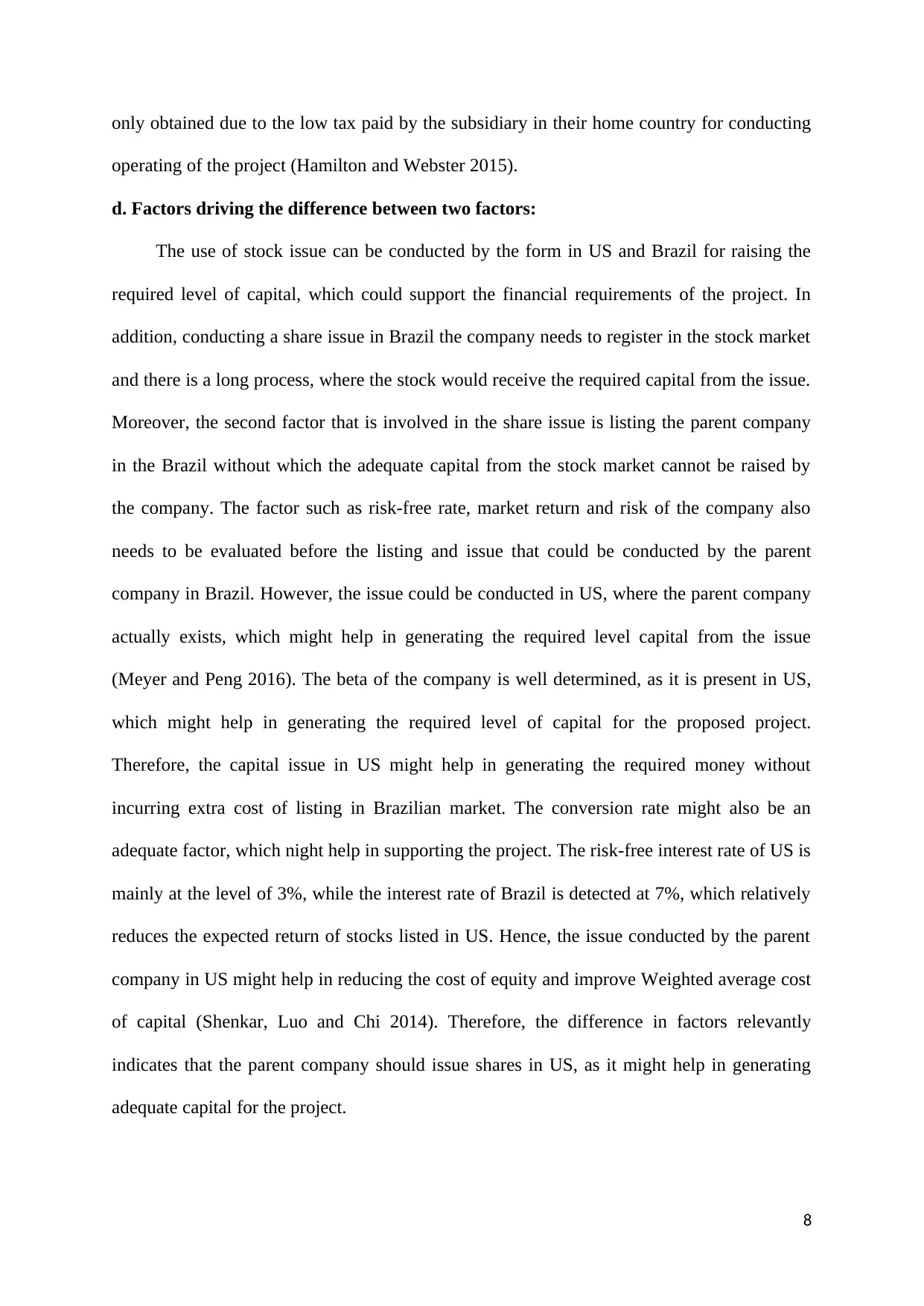
only obtained due to the low tax paid by the subsidiary in their home country for conducting
operating of the project (Hamilton and Webster 2015).
d. Factors driving the difference between two factors:
The use of stock issue can be conducted by the form in US and Brazil for raising the
required level of capital, which could support the financial requirements of the project. In
addition, conducting a share issue in Brazil the company needs to register in the stock market
and there is a long process, where the stock would receive the required capital from the issue.
Moreover, the second factor that is involved in the share issue is listing the parent company
in the Brazil without which the adequate capital from the stock market cannot be raised by
the company. The factor such as risk-free rate, market return and risk of the company also
needs to be evaluated before the listing and issue that could be conducted by the parent
company in Brazil. However, the issue could be conducted in US, where the parent company
actually exists, which might help in generating the required level capital from the issue
(Meyer and Peng 2016). The beta of the company is well determined, as it is present in US,
which might help in generating the required level of capital for the proposed project.
Therefore, the capital issue in US might help in generating the required money without
incurring extra cost of listing in Brazilian market. The conversion rate might also be an
adequate factor, which night help in supporting the project. The risk-free interest rate of US is
mainly at the level of 3%, while the interest rate of Brazil is detected at 7%, which relatively
reduces the expected return of stocks listed in US. Hence, the issue conducted by the parent
company in US might help in reducing the cost of equity and improve Weighted average cost
of capital (Shenkar, Luo and Chi 2014). Therefore, the difference in factors relevantly
indicates that the parent company should issue shares in US, as it might help in generating
adequate capital for the project.
8
operating of the project (Hamilton and Webster 2015).
d. Factors driving the difference between two factors:
The use of stock issue can be conducted by the form in US and Brazil for raising the
required level of capital, which could support the financial requirements of the project. In
addition, conducting a share issue in Brazil the company needs to register in the stock market
and there is a long process, where the stock would receive the required capital from the issue.
Moreover, the second factor that is involved in the share issue is listing the parent company
in the Brazil without which the adequate capital from the stock market cannot be raised by
the company. The factor such as risk-free rate, market return and risk of the company also
needs to be evaluated before the listing and issue that could be conducted by the parent
company in Brazil. However, the issue could be conducted in US, where the parent company
actually exists, which might help in generating the required level capital from the issue
(Meyer and Peng 2016). The beta of the company is well determined, as it is present in US,
which might help in generating the required level of capital for the proposed project.
Therefore, the capital issue in US might help in generating the required money without
incurring extra cost of listing in Brazilian market. The conversion rate might also be an
adequate factor, which night help in supporting the project. The risk-free interest rate of US is
mainly at the level of 3%, while the interest rate of Brazil is detected at 7%, which relatively
reduces the expected return of stocks listed in US. Hence, the issue conducted by the parent
company in US might help in reducing the cost of equity and improve Weighted average cost
of capital (Shenkar, Luo and Chi 2014). Therefore, the difference in factors relevantly
indicates that the parent company should issue shares in US, as it might help in generating
adequate capital for the project.
8
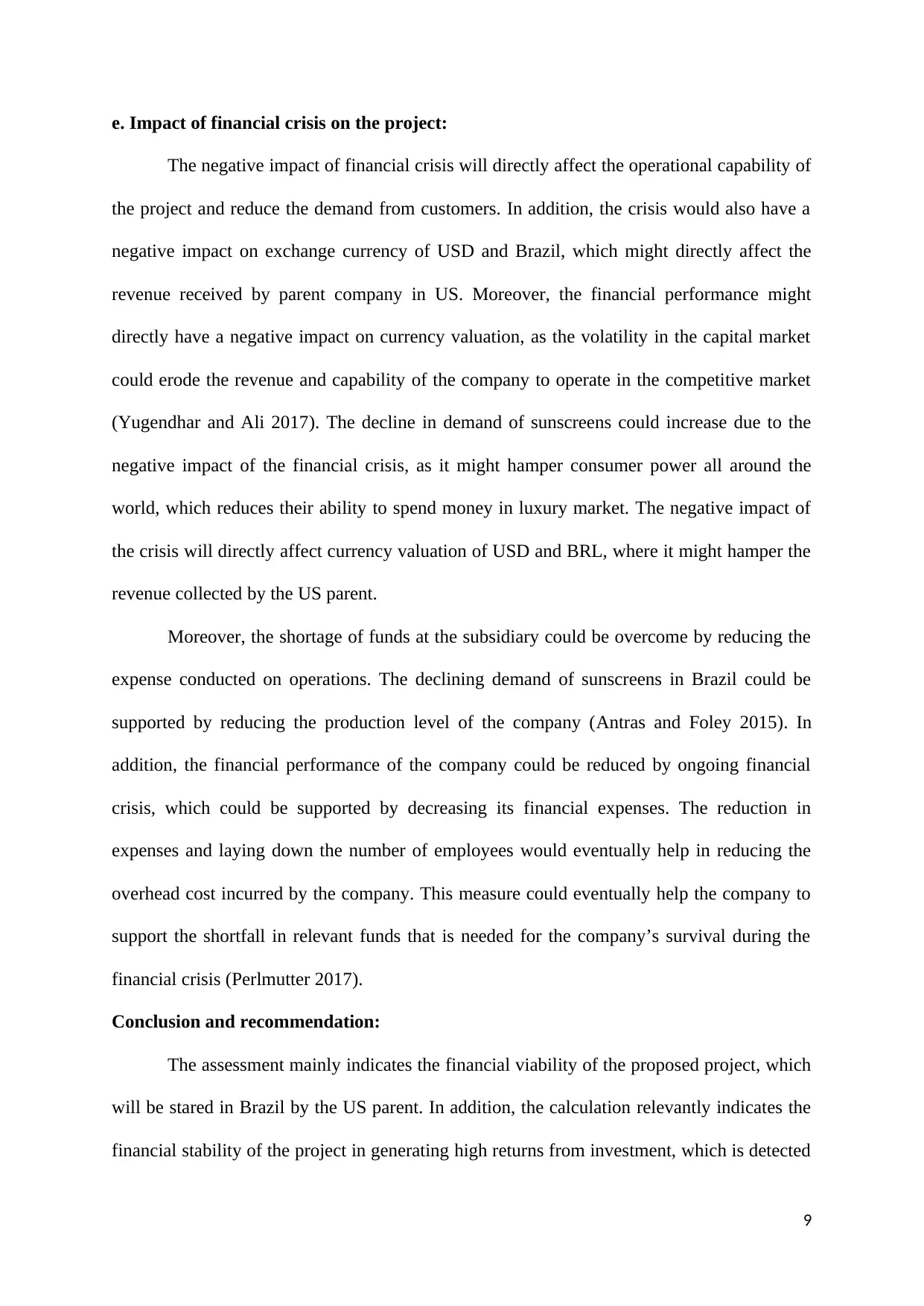
e. Impact of financial crisis on the project:
The negative impact of financial crisis will directly affect the operational capability of
the project and reduce the demand from customers. In addition, the crisis would also have a
negative impact on exchange currency of USD and Brazil, which might directly affect the
revenue received by parent company in US. Moreover, the financial performance might
directly have a negative impact on currency valuation, as the volatility in the capital market
could erode the revenue and capability of the company to operate in the competitive market
(Yugendhar and Ali 2017). The decline in demand of sunscreens could increase due to the
negative impact of the financial crisis, as it might hamper consumer power all around the
world, which reduces their ability to spend money in luxury market. The negative impact of
the crisis will directly affect currency valuation of USD and BRL, where it might hamper the
revenue collected by the US parent.
Moreover, the shortage of funds at the subsidiary could be overcome by reducing the
expense conducted on operations. The declining demand of sunscreens in Brazil could be
supported by reducing the production level of the company (Antras and Foley 2015). In
addition, the financial performance of the company could be reduced by ongoing financial
crisis, which could be supported by decreasing its financial expenses. The reduction in
expenses and laying down the number of employees would eventually help in reducing the
overhead cost incurred by the company. This measure could eventually help the company to
support the shortfall in relevant funds that is needed for the company’s survival during the
financial crisis (Perlmutter 2017).
Conclusion and recommendation:
The assessment mainly indicates the financial viability of the proposed project, which
will be stared in Brazil by the US parent. In addition, the calculation relevantly indicates the
financial stability of the project in generating high returns from investment, which is detected
9
The negative impact of financial crisis will directly affect the operational capability of
the project and reduce the demand from customers. In addition, the crisis would also have a
negative impact on exchange currency of USD and Brazil, which might directly affect the
revenue received by parent company in US. Moreover, the financial performance might
directly have a negative impact on currency valuation, as the volatility in the capital market
could erode the revenue and capability of the company to operate in the competitive market
(Yugendhar and Ali 2017). The decline in demand of sunscreens could increase due to the
negative impact of the financial crisis, as it might hamper consumer power all around the
world, which reduces their ability to spend money in luxury market. The negative impact of
the crisis will directly affect currency valuation of USD and BRL, where it might hamper the
revenue collected by the US parent.
Moreover, the shortage of funds at the subsidiary could be overcome by reducing the
expense conducted on operations. The declining demand of sunscreens in Brazil could be
supported by reducing the production level of the company (Antras and Foley 2015). In
addition, the financial performance of the company could be reduced by ongoing financial
crisis, which could be supported by decreasing its financial expenses. The reduction in
expenses and laying down the number of employees would eventually help in reducing the
overhead cost incurred by the company. This measure could eventually help the company to
support the shortfall in relevant funds that is needed for the company’s survival during the
financial crisis (Perlmutter 2017).
Conclusion and recommendation:
The assessment mainly indicates the financial viability of the proposed project, which
will be stared in Brazil by the US parent. In addition, the calculation relevantly indicates the
financial stability of the project in generating high returns from investment, which is detected
9
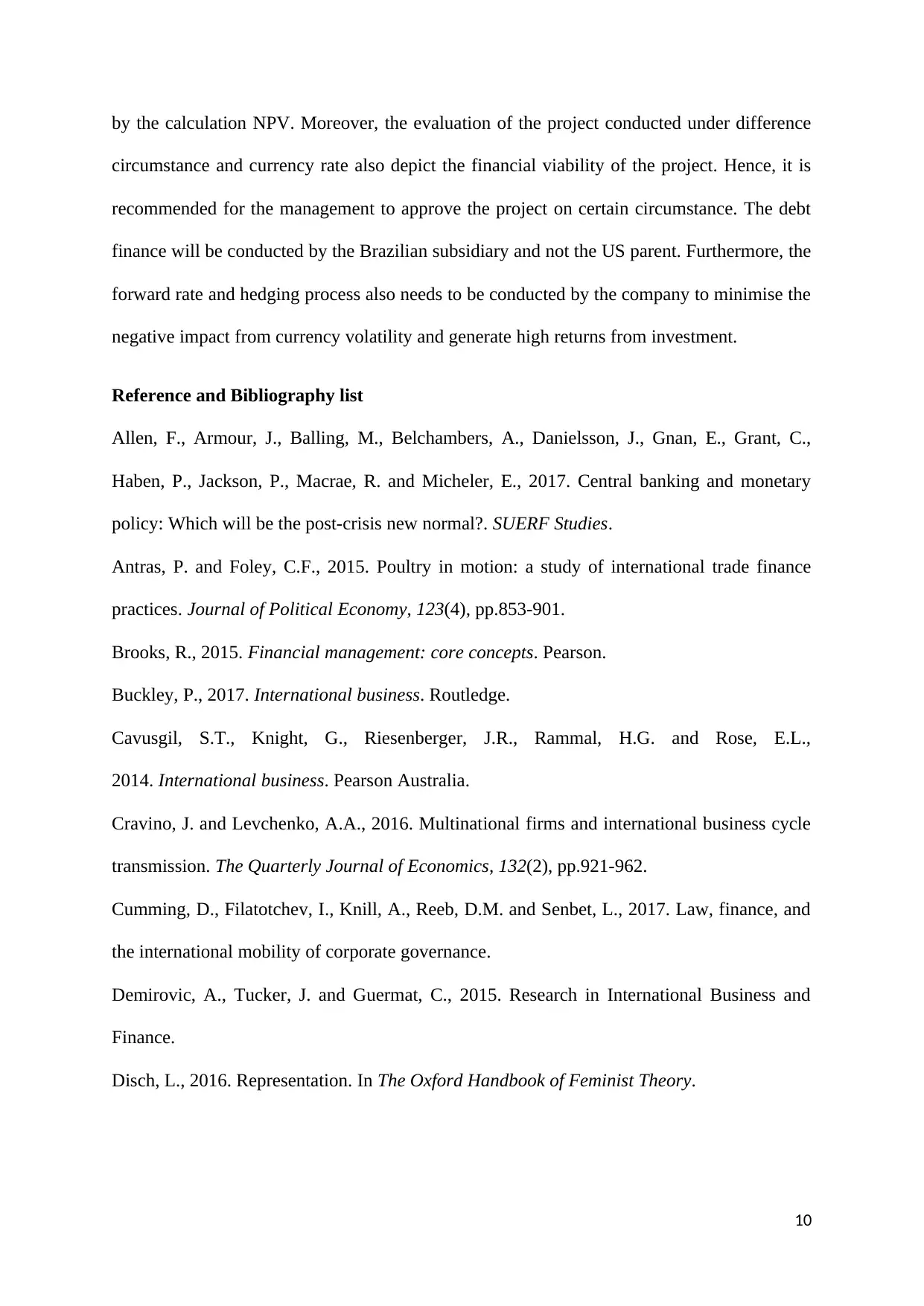
by the calculation NPV. Moreover, the evaluation of the project conducted under difference
circumstance and currency rate also depict the financial viability of the project. Hence, it is
recommended for the management to approve the project on certain circumstance. The debt
finance will be conducted by the Brazilian subsidiary and not the US parent. Furthermore, the
forward rate and hedging process also needs to be conducted by the company to minimise the
negative impact from currency volatility and generate high returns from investment.
Reference and Bibliography list
Allen, F., Armour, J., Balling, M., Belchambers, A., Danielsson, J., Gnan, E., Grant, C.,
Haben, P., Jackson, P., Macrae, R. and Micheler, E., 2017. Central banking and monetary
policy: Which will be the post-crisis new normal?. SUERF Studies.
Antras, P. and Foley, C.F., 2015. Poultry in motion: a study of international trade finance
practices. Journal of Political Economy, 123(4), pp.853-901.
Brooks, R., 2015. Financial management: core concepts. Pearson.
Buckley, P., 2017. International business. Routledge.
Cavusgil, S.T., Knight, G., Riesenberger, J.R., Rammal, H.G. and Rose, E.L.,
2014. International business. Pearson Australia.
Cravino, J. and Levchenko, A.A., 2016. Multinational firms and international business cycle
transmission. The Quarterly Journal of Economics, 132(2), pp.921-962.
Cumming, D., Filatotchev, I., Knill, A., Reeb, D.M. and Senbet, L., 2017. Law, finance, and
the international mobility of corporate governance.
Demirovic, A., Tucker, J. and Guermat, C., 2015. Research in International Business and
Finance.
Disch, L., 2016. Representation. In The Oxford Handbook of Feminist Theory.
10
circumstance and currency rate also depict the financial viability of the project. Hence, it is
recommended for the management to approve the project on certain circumstance. The debt
finance will be conducted by the Brazilian subsidiary and not the US parent. Furthermore, the
forward rate and hedging process also needs to be conducted by the company to minimise the
negative impact from currency volatility and generate high returns from investment.
Reference and Bibliography list
Allen, F., Armour, J., Balling, M., Belchambers, A., Danielsson, J., Gnan, E., Grant, C.,
Haben, P., Jackson, P., Macrae, R. and Micheler, E., 2017. Central banking and monetary
policy: Which will be the post-crisis new normal?. SUERF Studies.
Antras, P. and Foley, C.F., 2015. Poultry in motion: a study of international trade finance
practices. Journal of Political Economy, 123(4), pp.853-901.
Brooks, R., 2015. Financial management: core concepts. Pearson.
Buckley, P., 2017. International business. Routledge.
Cavusgil, S.T., Knight, G., Riesenberger, J.R., Rammal, H.G. and Rose, E.L.,
2014. International business. Pearson Australia.
Cravino, J. and Levchenko, A.A., 2016. Multinational firms and international business cycle
transmission. The Quarterly Journal of Economics, 132(2), pp.921-962.
Cumming, D., Filatotchev, I., Knill, A., Reeb, D.M. and Senbet, L., 2017. Law, finance, and
the international mobility of corporate governance.
Demirovic, A., Tucker, J. and Guermat, C., 2015. Research in International Business and
Finance.
Disch, L., 2016. Representation. In The Oxford Handbook of Feminist Theory.
10
Secure Best Marks with AI Grader
Need help grading? Try our AI Grader for instant feedback on your assignments.
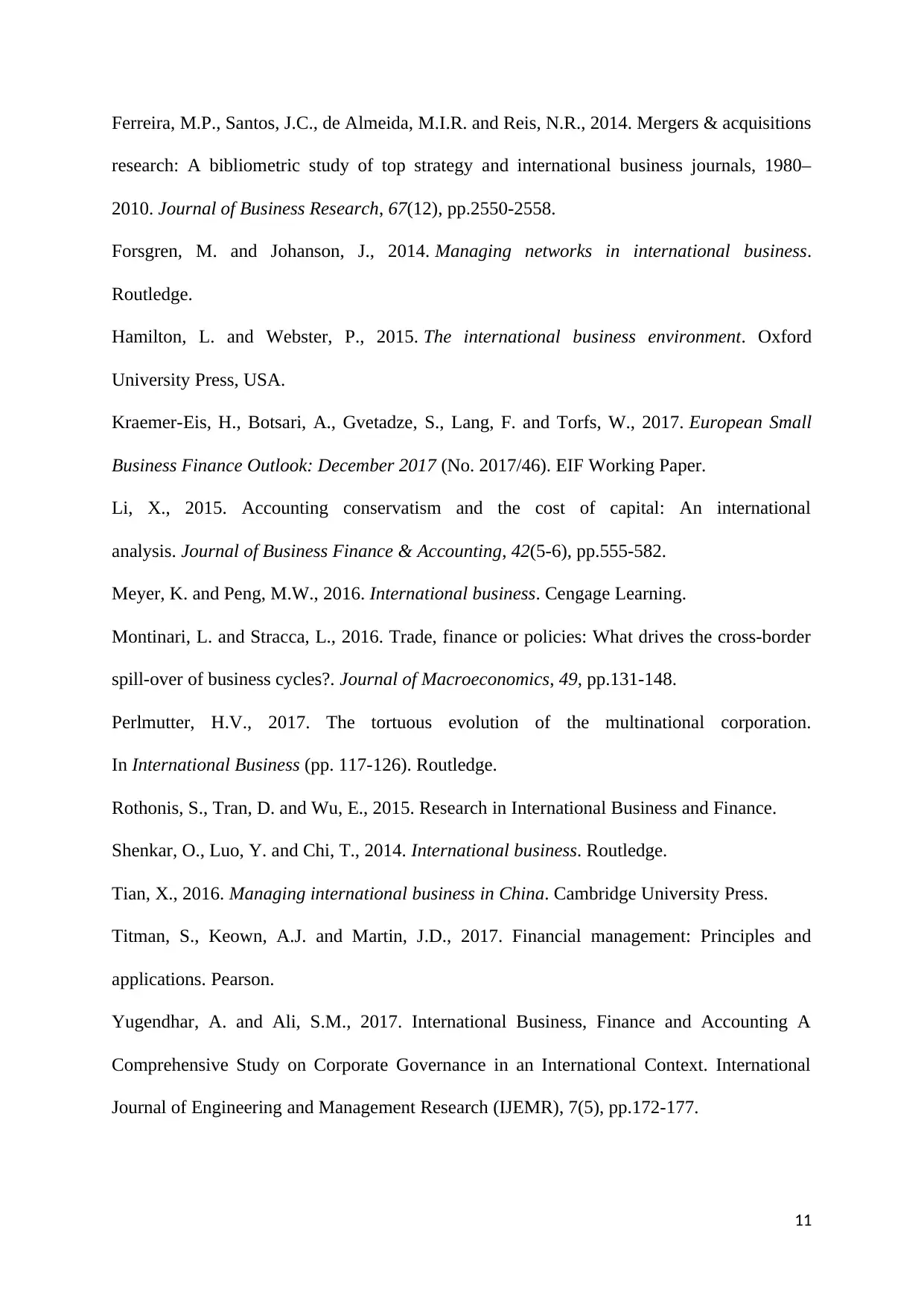
Ferreira, M.P., Santos, J.C., de Almeida, M.I.R. and Reis, N.R., 2014. Mergers & acquisitions
research: A bibliometric study of top strategy and international business journals, 1980–
2010. Journal of Business Research, 67(12), pp.2550-2558.
Forsgren, M. and Johanson, J., 2014. Managing networks in international business.
Routledge.
Hamilton, L. and Webster, P., 2015. The international business environment. Oxford
University Press, USA.
Kraemer-Eis, H., Botsari, A., Gvetadze, S., Lang, F. and Torfs, W., 2017. European Small
Business Finance Outlook: December 2017 (No. 2017/46). EIF Working Paper.
Li, X., 2015. Accounting conservatism and the cost of capital: An international
analysis. Journal of Business Finance & Accounting, 42(5-6), pp.555-582.
Meyer, K. and Peng, M.W., 2016. International business. Cengage Learning.
Montinari, L. and Stracca, L., 2016. Trade, finance or policies: What drives the cross-border
spill-over of business cycles?. Journal of Macroeconomics, 49, pp.131-148.
Perlmutter, H.V., 2017. The tortuous evolution of the multinational corporation.
In International Business (pp. 117-126). Routledge.
Rothonis, S., Tran, D. and Wu, E., 2015. Research in International Business and Finance.
Shenkar, O., Luo, Y. and Chi, T., 2014. International business. Routledge.
Tian, X., 2016. Managing international business in China. Cambridge University Press.
Titman, S., Keown, A.J. and Martin, J.D., 2017. Financial management: Principles and
applications. Pearson.
Yugendhar, A. and Ali, S.M., 2017. International Business, Finance and Accounting A
Comprehensive Study on Corporate Governance in an International Context. International
Journal of Engineering and Management Research (IJEMR), 7(5), pp.172-177.
11
research: A bibliometric study of top strategy and international business journals, 1980–
2010. Journal of Business Research, 67(12), pp.2550-2558.
Forsgren, M. and Johanson, J., 2014. Managing networks in international business.
Routledge.
Hamilton, L. and Webster, P., 2015. The international business environment. Oxford
University Press, USA.
Kraemer-Eis, H., Botsari, A., Gvetadze, S., Lang, F. and Torfs, W., 2017. European Small
Business Finance Outlook: December 2017 (No. 2017/46). EIF Working Paper.
Li, X., 2015. Accounting conservatism and the cost of capital: An international
analysis. Journal of Business Finance & Accounting, 42(5-6), pp.555-582.
Meyer, K. and Peng, M.W., 2016. International business. Cengage Learning.
Montinari, L. and Stracca, L., 2016. Trade, finance or policies: What drives the cross-border
spill-over of business cycles?. Journal of Macroeconomics, 49, pp.131-148.
Perlmutter, H.V., 2017. The tortuous evolution of the multinational corporation.
In International Business (pp. 117-126). Routledge.
Rothonis, S., Tran, D. and Wu, E., 2015. Research in International Business and Finance.
Shenkar, O., Luo, Y. and Chi, T., 2014. International business. Routledge.
Tian, X., 2016. Managing international business in China. Cambridge University Press.
Titman, S., Keown, A.J. and Martin, J.D., 2017. Financial management: Principles and
applications. Pearson.
Yugendhar, A. and Ali, S.M., 2017. International Business, Finance and Accounting A
Comprehensive Study on Corporate Governance in an International Context. International
Journal of Engineering and Management Research (IJEMR), 7(5), pp.172-177.
11
1 out of 11
Related Documents
Your All-in-One AI-Powered Toolkit for Academic Success.
+13062052269
info@desklib.com
Available 24*7 on WhatsApp / Email
![[object Object]](/_next/static/media/star-bottom.7253800d.svg)
Unlock your academic potential
© 2024 | Zucol Services PVT LTD | All rights reserved.




